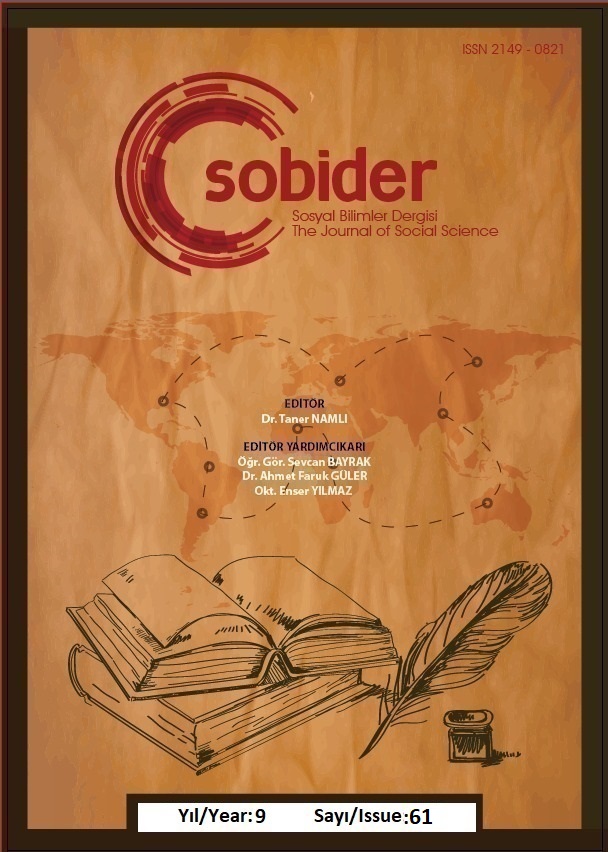Author :
Abstract
Mitik devirlerden günümüze kadar insanların yaratıcılık ve hayal güçleriyle oluşturdukları anlatılar çeşitli yollarla nesilden nesile aktarılmıştır. Oluşturulan eserler, kolektif bilincin desteğiyle sözlü ve yazılı kültür ile beslenmiştir. Kolektif bilincin meydana getirdiği anlatılardan biri olan efsaneler gerek inandırıcılığı gerekse somut verilerle desteklenmesiyle canlı bir biçimde yaşamaya devam etmiştir. Bu bağlamda efsanelerin yoğun olarak anlatıldığı yerlerden biri de Hatay’dır. Tabiat unsurları, tarihî olay ve kişiler, dinî olaylar, vb.’leri hakkında anlatılan efsaneler arasında din ve tarih unsurunu birleştiren kesik baş efsaneleri özellikle dikkati çekmektedir. Hatay’da hem Müslümanlık hem de Hristiyanlık için âdeta sembolik bir değer hâline gelen Habib-i Neccar, kesik baş efsanelerinin de merkezinde yer almaktadır. Bunun yanında dinî veya millî değerler uğruna savaşırken başı kesilen farklı kişiler de Hatay’da hem makamlar hem de menkıbelerle yaşatılmaya devam etmektedir. Makalede, Hatay’da anlatılan kesik baş efsaneleri, başların kesilme nedenlerine göre tasnif edilmiştir. Bu tasnif doğrultusunda kesik baş efsanelerinde yer alan semboller incelenecek, kesik başlı türbe/makam ve ziyaretlerde gerçekleştirilen dinî pratik ve uygulamalar tespit edilecektir.
Keywords
Abstract
Since the mythical ages, the narratives that people have formed with their creativity and imagination have reached the present day through various sources. The created works were nourished by oral and written culture with the support of collective consciousness. Legends, which have been created one of the narratives by the collective consciousness, have continued to live supported by both their credibility and concrete data. In this contex Hatay is one of the places that legends tell intensely. Among the legends told about the elements of nature, historical events, people and religious events, etc., the legends of the severed head that combine the elements of religion and history remark. Habib-i Neccar has become a symbolic value for both islam and christanity in Hatay and is also center of the legend of the severed head. In addition, different charachters who were cut their head while fighting for religion and national values continue to live with both rank and legends. In this article, legends of severed head are geraded according to the reasons of decapitation in hatay.In line with this classification, the symbols in the legends of the severed head will be examined and the religious practices performed during the visits to the cut-headed tombs and maqams will be determined.
Keywords
- Alptekin, Ali Berat (2012); Efsane ve Motifleri Üzerine, Akçağ Yayınları, Ankara.
- Aslan, Kadir (1997); Dörtyol Yer Adları, Efsaneler, Ağıtlar, Dörtyol Belediyesi Kültür Yayınları, Antakya.
- Berkli, Yunus (2007); “Mezartaşlarında Görülen Kılıç, Hançer, Ok-Yay ve Bayrak Motiflerinin Sembolik Anlamları”, Ekev Akademi Dergisi, S.31, 67-80.
- Cassirer, Ernst (2011); Sembol Kavramının Doğası (Çev. Milay Köktürk), Hece Yayınları, Ankara.
- Chevalier, Jean ve Alain Gheerbrant (1990); Dictionnaire des Symboles, “Téte Maddesi”, 943, Paris.
- Değer, Mete Bülent (2014); Hatay Efsanelerinin Bağlam Merkezli Halk Bilimi Yöntemleri Açısından İncelenmesi, Mersin Üniversitesi Sosyal Bilimler Enstitüsü (Basılmamış Yüksek Lisans Tezi), Mersin.
- Eliade, Mircea (2009); Dinler Tarihine Giriş, Kabalcı Yayınevi, İstanbul.
- Eliade, Mircea (2011); Demirciler ve Simyacılar, Kabalcı Yayınevi, İstanbul.
- Eyuboğlu, İsmet Zeki (1990); Bütün Yönleriyle Tasavvuf Tarikatlar Mezhepler Tarihi, Der Yayınları, İstanbul.
- Freud, Sigmund (2013); Rüyaların Yorumu (Çev. İhsan Kırımlı), C.1, Alter Yayıncılık, Ankara.
- Fromm, Erich (1990); Rüyalar, Masallar, Mitoslar (Çev. Aydın Arıtan ve Kaan H. Ökten), Arıtan Yayınevi, İstanbul.
- Jung, Carl G. (2016); İnsan ve Sembolleri, Kabalcı Yayıncılık, İstanbul.
- Kocatürk, Vasfi Mahir (1964); Türk Edebiyatı Tarihi, Edebiyat Yayınevi, Ankara.
- Ocak, Ahmet Yaşar (1989); Türk Folklorunda Kesik Baş, Türk Kültürünü Araştırma Enstitüsü Yayınları, Ankara.
- Örnek, Sedat Veyis (2014); 100 Soruda İlkellerde Din, Büyü, Sanat, Efsane, Bigesu Yayıncılık,
- Özdemir, Serdar Deniz (2022); Türk Halk Anlatılarında Devler, Paradigma Akademi, Çanakkale.
- Sakaoğlu, Saim (2009); Efsane Araştırmaları, Kömen Yayıncılık, Konya.
- Schimmel, Annemarie (1991); Sayıların Gizemi, Kabalcı Yayıncılık, İstanbul.
- Şahin, Veysel (2008); “Ömer Seyfettin’in ‘Başını Vermeyen Şehit’ Adlı Öyküsünde Kendilik Bilinci”, Türk Dili, C. XCVI, S.680, 111-123.
- Şenocak, Ebru (2007); “‘Canbulat Paşa’ Adlı Kıbrıs Efsanesinden Hareketle Türk Efsanelerinde Kendilik Bilinci”, Akra Kültür Sanat ve Edebiyat Dergisi, C.5, S.13, 83-103.
- Tekin, Mehmet (2011); Habib Neccar ve Antakya, Color Ofset, İskenderun.
- Türk, Hüseyin (2012); “Hatay Türbe İnancının Sağlık Antropolojisi Açısından İncelenmesi”, Millî Folklor, S.94, 91-104.
- Türkçe Sözlük C.2 (1988); Türk Dil Kurumu Yayınları, Ankara.
- 1979 Karacurun Yayladağı Üniversite Memur
- K2 Hıdır Parlar 1963 İskenderun Lise Şeyh (Emekli) İskenderun 2021
- K3 Hikmet Özben 1962 Adana Lise Şeyh Samandağ 2015
- K4 Leyla Hantı 1947 Yeniyapan Hassa
- Ev Hanımı Hassa 2019
- K5 Sabiha Geldi 1947 Altınözü İlkokul Ev Hanımı Belen 2020
- K6 Samra Zorlu 1957 Antakya İlkokul Ev Hanımı İskenderun 2019
- K7 Uğur Dede 1963 Dörtyol Yüksekokul Terk





